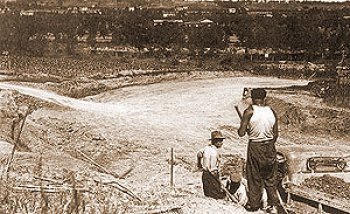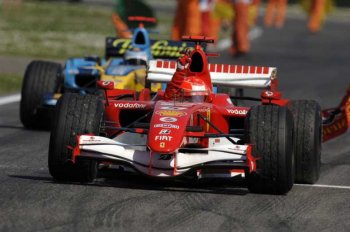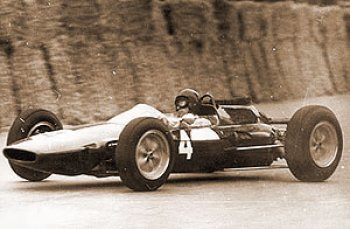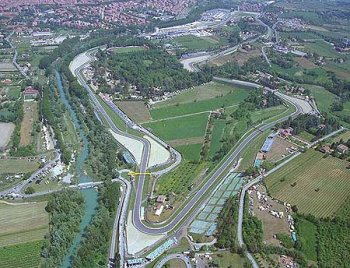|
The FIA
published the provisional 2007 Formula One calendar this
morning morning, and with it came the news that the San
Marino Grand Prix - held for the last 26 years at the famous
Autodromo Internazionale Enzo e Dino Ferrari di Imola - will
loose its place on the calendar.
The famous second Italian-based grand prix, which takes its
title from the tiny mountaintop principality of San Marino,
joins the European Grand Prix - held in recent years at the
Nürburgring - in being dropped, while the Belgium round at
Spa returns, making for a 17-race 2007 schedule. Both Italy
and Germany already hold a Grand Prix each, and the loss of
their "second" fixtures is primarily down to a massive
global expansion in appeal of the F1 series in recent years
that has seen a diverse spread of countries such as China,
Malaysia, Bahrain and Turkey joining the calendar for the
first time. With many other countries - including Russia,
South Africa and India - all seeking to stage a Grand Prix
of their own, it will be very difficult for Imola to regain
its place on the calendar if it is lost.
The German F1 round is now expected to alternate between
Hockenheim and the Nürburgring, although the four-week gap
in the 2007 calendar between Bahrain and Spain will
doubtless lead to speculation that the San Marino Grand Prix
could yet be reinstated. In truth in recent years Imola has
faced the axe several times, but survived at the last
minute, and 2007 could still see the 2.4-litre V8 Grand Prix
engines screaming around this famous track.
Few circuits inspire the same adoration for motorsport as
Imola. The circuit lies in the heart of Ferrari country and
is a stone's throw from both Modena and Maranello. It is the
home of the tifosi and a place of pilgrimage for any fan of
Italian motorsport. The track has seen some memorable races
over the years and although it is in Italy, the circuit
plays host to the San Marino Grand Prix. For the citizens of
Imola the desire for speed has been part of their make-up
since ancient times. When Imola was called Cornelli Forum,
at the time of the ancient Roman civilisation in the year 80
before Christ, it was an amphitheatre where two wheeled
charriots used to race, in preparation for the steel horses.
The foundations of the current racetrack can be traced back
to the 1940s. To financially help (and provide work) for a
depressed economy of the post war era, a series of public
works were launched, including the construction of a road
which connected the "via Emilia", where today there is the
Rivazza bend, to the village of Codrigano, reaching the "Tosa
bend". Then four motor racing enthusiasts from Imola
(Alfredo Campagnoli, Graziano Golinelli, Ugo Montevecchi and
Gualtiero Vighi) had the idea of building a race circuit in
these hills. In addition to the enthusiasm of these four,
the initiative of Checco Costa was then added, who was to
become the organiser of major motorcycle events.
On the 22nd March 1950 the first stone of the racetrack was
laid, but work proceeded slowly due to bureaucratic problems
and difficulty in acquiring the neighbouring land. It was
not until 1954 that the first car race took place on the
track. In 1963, however, the organisers collected a large
purse and asked the Formula One teams if they would run in a
non-championship event between the Pau and Pescara races.
Most agreed, although Ferrari was notable by its absence.
|
 |
|
On the 22nd March 1950
the first stone of the Imola racetrack was laid
down, but work proceeded slowly due to bureaucratic
problems and difficulty in acquiring the
neighbouring land. |
|
 |
|
A large statue remembers the tragedy
on 1st May 1994
when the Imola circuit claimed the life of one of
Formula One's greatest ever drivers, Ayrton Senna,
during the 14th San Marino Grand Prix. |
|
|
 |
|
Michael Schumacher
(Ferrari 248 F1) wins the 2007 San Marino Grand Prix
- the 26th edition - at the Autodromo Internazionale Enzo e Dino Ferrari di
Imola, which could turn out to be the last F1 race
to be held at the famous circuit. |
|
 |
|
On 21st April 1963, the
Formula 1 cars took to the track for the first time
at Imola in a non-championship race. On Jim Clark's
day of triumph with the legendary Lotus 25, the
absence of Ferrari stood out, after having promised
to take part. |
|
 |
|
Few circuits inspire the same adoration for
motorsport as Imola. The circuit lies in the heart
of Ferrari country and is a stone's throw from both
Modena and Maranello. It is the home of the tifosi
and a place of pilgrimage for any fan of Italian
motorsport. |
|
|
The Imola Town
Council decided to rename the circuit in honour of Enzo
Ferrari's son Dino who had tragically died in 1956. The
renaming of the track led to a loyalty from Enzo and the
Circuit Dino Ferrari soon raised enough money to turn the
track into a permanent closed circuit. When the great man
died, the circuit was renamed, Circuit Enzo e Dino Ferrari.
1979 saw Formula One return to the track with the running of
another non-championship event. In 1980, Imola hosted the
Italian Grand Prix, the first and only time it would do so.
1981 saw the return of the Italian Grand Prix to Monza, but
so popular was Imola that the San Marino Grand Prix was
launched to make use of the circuit. 1982 saw one of the
most legendary races in Formula One history. Having crashed
at the corner which would later bear his name in 1981,
Gilles Villeneuve returned to Imola determined to win.
However, after a titanic battle his team mate at Ferrari,
Didier Pironi, took the lead and won the race. Villeneuve
was incensed as he claimed Pironi had broken team orders. He
swore never to speak to him again. He never would. At the
next race in Zolder, Villeneuve was killed in a horrifying
accident in qualifying.
In 1983 Villeneuve's friend Patrick Tambay raced at Imola
for Ferrari. He took Villeneuve's number 27 to victory. It
was a most unlikely win, and legend says that Tambay
recalled the car doing things he was not asking it to do. He
said it was as if Gilles had been in the car with him. The
magic of Imola was born. In 1987 and 1989 Nelson Piquet and
Gerhard Berger had big accidents at the high speed
Tamburello corner. They emerged relatively unscathed, but in
1994 the corner claimed the life of one of Formula One's
greatest drivers, Ayrton Senna. In one of the sport's
darkest weekends Rubens Barrichello was knocked unconscious
on Friday morning. Roland Ratzenberger, the much loved
Austrian rookie, was tragically killed on Saturday with
minutes of qualifying left. The race itself saw collisions,
stray tyres in the pit lane, and, most tragically, the death
of Senna.
Despite the events of 1994, Imola has retained some of its
magic. It is still a marvellous circuit with corners such as
Acque Minerale providing real challenges for the modern
Formula One driver. The atmosphere created by the tifosi is
unlike anything on earth. They live and breathe Ferrari and
give Imola a special type of magic you won't find anywhere
else.
|
|
|
|